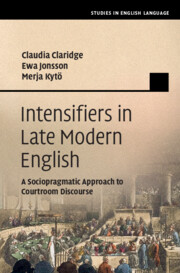Book contents
- Intensifiers in Late Modern English
- Studies in English Language
- Intensifiers in Late Modern English
- Copyright page
- Dedication
- Contents
- Figures
- Tables
- Acknowledgements
- Abbreviations and Notations
- Chapter 1 Introduction
- Chapter 2 Theoretical and Methodological Considerations
- Chapter 3 Intensifiers
- Chapter 4 Corpus Methodology and Overview of Data
- Chapter 5 Maximizers
- Chapter 6 Boosters
- Chapter 7 Downtoners
- Chapter 8 Multivariate Analysis
- Chapter 9 Intensifiers across Time
- Chapter 10 The Pragmatics of Intensifiers
- Chapter 11 The Sociolinguistics of Intensifiers
- Chapter 12 Conclusion
- Book part
- Bibliography
- Index
Chapter 7 - Downtoners
Published online by Cambridge University Press: 15 March 2024
- Intensifiers in Late Modern English
- Studies in English Language
- Intensifiers in Late Modern English
- Copyright page
- Dedication
- Contents
- Figures
- Tables
- Acknowledgements
- Abbreviations and Notations
- Chapter 1 Introduction
- Chapter 2 Theoretical and Methodological Considerations
- Chapter 3 Intensifiers
- Chapter 4 Corpus Methodology and Overview of Data
- Chapter 5 Maximizers
- Chapter 6 Boosters
- Chapter 7 Downtoners
- Chapter 8 Multivariate Analysis
- Chapter 9 Intensifiers across Time
- Chapter 10 The Pragmatics of Intensifiers
- Chapter 11 The Sociolinguistics of Intensifiers
- Chapter 12 Conclusion
- Book part
- Bibliography
- Index
Summary
This chapter is devoted to downtoners, namely moderators, diminishers and minimizers, with the 19 attested types amounting to 7,874 examples. The dominant type a little constitutes 66 per cent of the occurrences and is followed by hardly with 13 per cent. The distribution of the five most frequent downtoners across the period studied is discussed, and compared to the BNC trials data. The decline in the use of diminisher a little accounts for the overall decline in the use of downtoners in the OBC data. The source terms of downtoners display a more varied spectrum of semantic shades than maximizers and boosters. There is also a greater variety of target categories than attested for boosters and maximizers: the otherwise most frequent targets adjectives are here outranked by prepositional phrases and verbs, with the latter standing out as the specialty of downtoners compared to all other intensifiers. They predominantly modify verbs of the material and mental process types; in the semantic classes of downtoned adjectives, the category of human propensity dominates. As for collocational profiles, for instance a little dominates in collocations with after, before and more.
Keywords
- Type
- Chapter
- Information
- Intensifiers in Late Modern EnglishA Sociopragmatic Approach to Courtroom Discourse, pp. 163 - 194Publisher: Cambridge University PressPrint publication year: 2024

